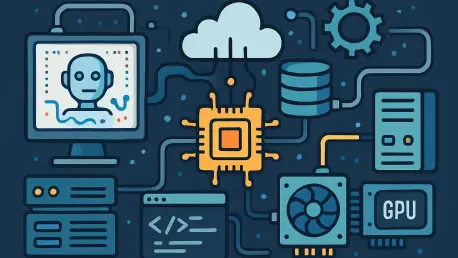With artificial intelligence becoming an integral part of business operations, the demand for powerful AI infrastructure tools continues to rise. The technological landscape in 2025 has seen massive advancements, specifically in how businesses integrate AI tools to streamline operations, drive efficiency, and maintain competitiveness. Companies are increasingly investing in sophisticated generative AI infrastructure to meet this growing demand. The selection of an appropriate tool is critical, as it influences not only the scalability and performance but also compliance with evolving legal standards and data handling protocols. This article provides an insightful analysis of some of the most pioneering generative AI infrastructure tools dominating the market, with a keen eye on their distinctive features and strategic advantages.
Evolution of AI Infrastructure Tools
Integration and Multilingual Capabilities
One of the primary trends in generative AI infrastructure tools is the ability to seamlessly integrate with existing systems while providing robust multilingual support. A notable example is Vertex AI, which offers an exceptional platform for natural language processing workflows. As enterprises expand their operations globally, the need for AI tools that support multiple languages becomes ever more critical. Vertex AI addresses this requirement with its pre-built machine learning algorithms that allow businesses to automate and deploy machine learning scripts efficiently. The integration capacity ensures minimal disruption during the onboarding process and supports existing legacy systems by smoothly assimilating into different operational frameworks.
Moreover, the importance of integration goes beyond language support. Enterprises rely on these tools’ ability to connect various applications, ensuring a streamlined flow of data across multiple platforms. This is especially critical in industries where real-time data processing is essential, such as in finance or customer service sectors. The advent of AI has necessitated a paradigm shift in strategies where integration is key for seamless operations and maintaining interoperability between diverse systems. These advancements, coupled with continued support and improvements in AI models, set the stage for sustainable growth and enhanced efficiency in businesses worldwide.
Beginner-Friendly and No-Code Solutions
Another significant trend in the development of AI infrastructure tools is the movement toward more user-friendly, no-code platforms. This is embodied by tools like Botpress, which have made strides in democratizing AI accessibility. By removing the complexities traditionally associated with AI deployment, such tools allow even non-technical teams within organizations to harness the power of AI in creating chatbots and other automated solutions. This has led to a notable shift as technology becomes more inclusive and enterprise-level AI solutions become more widespread. Organizations no longer need to rely on highly specialized technical teams to deploy AI capabilities; instead, they can enable broader teams across decision-making chains to engage with and benefit from AI tools.
Platforms like Botpress have further advanced this approach by fostering an environment where intuitive drag-and-drop interfaces replace intricate programming and coding requirements. This evolution is critical in the current business ecosystem, where agility and swift adaptation are indispensable. The evolving consumer landscape demands fast responses and innovative solutions, pushing companies to adopt tools that reconcile functionality with ease of use. As companies leverage these user-friendly platforms, they redefine traditional roles by empowering employees to contribute directly to innovation, regardless of their technical expertise, transforming everyday operations into a fertile ground for AI development and application.
Meeting AI Demand with Robust Platforms
High-Performance Computational Capabilities
Robust computational capabilities stand at the forefront of the requirements for generative AI tools, as evidenced by the offerings of Google Cloud AI Infrastructure and Nvidia AI Enterprise. These platforms are known for their high-performance capabilities that support the demanding requirements of training complex machine learning models. This demand is particularly evident in industries where vast amounts of data need to be processed rapidly and accurately. Nvidia AI Enterprise, for example, provides deep integration with Nvidia GPUs, rendering a platform that significantly enhances the speed and efficiency of AI model training. The ability of these tools to handle such intense computational tasks is pivotal in sectors like healthcare, where AI models are used for predictive analytics and diagnostics.
Moreover, the scalability of these platforms ensures that businesses can grow their AI operations without being constrained by infrastructure limitations. Google Cloud AI Infrastructure offers versatile Tensor Processing Unit capabilities that facilitate scalable artificial intelligence pipelines. This scalability is critical for enterprises aiming to expand their AI capabilities in line with growing demands and market presence. These tools provide an adaptive framework that businesses can rely on for sustained innovation and continuous development in AI, positioning them well in an era where data-driven decision-making and automation are not just advantageous but essential for success.
Scaling AI with Cloud-Based Frameworks
Cloud-based frameworks play an essential role in scaling AI operations, as seen in platforms like AWS Bedrock and Saturn Cloud. These tools are designed to optimize the use of cloud resources for extensive AI deployment and management. AWS Bedrock provides multi-model access that extends its utility across diverse AI applications. The platform’s integration with AWS cloud services allows businesses to capitalize on the elasticity of cloud computing, providing a flexible environment that can be adjusted based on changing business requirements. The integration also eliminates the complexities of maintaining extensive on-premise infrastructure, translating to reduced overhead costs and enhanced access to cutting-edge technology.
Saturn Cloud, on the other hand, is optimized for scalable Python and AI development, offering a user-friendly approach toward deploying and managing AI applications. Its robust integration capabilities empower users to easily manage their cloud environments while focusing on developing core AI capabilities. By leveraging the power of the cloud, these platforms support rapid prototyping and deployment phases, which are critical for innovation cycles in technological development. The cloud offers not only enhanced computational resources but also increased speed to market, all of which are vital for businesses seeking to remain competitive in fast-paced industry landscapes.
Strategic Considerations for AI Investments
Compliance and Legal Frameworks
As generative AI continues to evolve, so does the regulatory environment governing its application. Businesses must ensure compliance with AI content regulations, which serve to protect data integrity, consumer privacy, and ethical AI usage. The selection of AI infrastructure tools should be informed by their ability to comply with these legal frameworks. Platforms that offer secure data handling and emphasize transparency in operations stand out as preferred choices for enterprises sensitive to the reputational and operational risks associated with non-compliance. The engagement with platforms that prioritize legal adherence not only safeguards against potential liabilities but also fortifies trust with consumers and stakeholders.
In addition to data compliance, these tools should offer clarity and guidance on navigating the intricate legal landscape of AI deployment. The emphasis should be placed on robust privacy safeguards, ethical considerations, and adhering to international best practices in AI development. Legal compliance remains a critical aspect as industries seek to harness AI’s potential while maintaining fiduciary and societal obligations. Companies embarking on AI investments must balance their aspirations against the necessity for adherence to standards that assure sustainable and responsible AI innovation.
Balancing Costs and Executive Support
A quintessential challenge in AI investment is balancing the budgetary constraints with ambitious AI goals. As technology continues to advance rapidly, businesses face financial implications associated with acquiring top-tier AI infrastructure. Companies must carefully strategize their investment, ensuring that it aligns with both their financial capabilities and strategic business objectives. Developing a thorough understanding of the costs associated with scaling AI operations—such as resource management, customization, and deployment—is key in formulating a suitable investment plan. Cost-effective resource management is crucial in creating an AI strategy that is sustainable and successful in the long term.
Executive support, thus, plays a crucial role in fostering a positive business environment conducive to AI adoption. Senior leadership is often instrumental in championing AI initiatives, securing necessary funding, and embedding AI-driven strategies into corporate culture. Ensuring that the leadership team is aligned with the AI vision redefines a company’s potential for innovation, efficiency, and strategic growth. With industry trends gravitating towards pervasive AI use, leaders must advocate for intelligent investments that not only fulfill present needs but also offer transformative potential. Overall, strategic planning and leadership endorsement will facilitate successful AI integration, preparing the ground for future industry developments.
Looking Forward: The Transformative Power of AI
Future Possibilities and Innovations
The landscape for generative AI infrastructure is expected to continue evolving, with cutting-edge technologies laying the groundwork for future innovations. As businesses increasingly depend on AI to drive growth and innovation, tools that offer enhanced capabilities and intuitive functionalities will remain crucial for success. The continuous development in areas such as machine learning frameworks, computational precision, and intelligent automation suggests that future AI tools will provide even greater precision and adaptability to meet diverse business needs. There is an opportunity for businesses to experiment with AI-led innovations, especially in augmenting existing services and expanding into new markets.
Moreover, horizon-gazing into technologies such as quantum computing integration with AI infrastructure could revolutionize how companies handle data processing and computational tasks. These future possibilities underscore the importance of staying abreast of technological advancements and implementing adaptive strategies. The seamless interplay of technology with business processes will drive innovation, creating new paradigms for AI’s role in the business ecosystem. Business leaders must continue fostering a culture of innovation, encouraging exploration, and leveraging the transformative power of AI to stay ahead in the competitive landscape.
Strategizing for Business Success
A notable trend in AI infrastructure development is the rise of user-friendly, no-code platforms. Tools like Botpress exemplify this shift by making AI more accessible to non-technical users. Traditionally, AI deployment required a deep understanding of complex technologies, but platforms like Botpress eliminate those hurdles. Now, organizations can utilize AI for creating chatbots and automated solutions without relying solely on specialized technical teams. This democratization allows broader participation across decision-making processes and greatly expands AI’s reach within enterprises.
Botpress and similar platforms have introduced intuitive drag-and-drop interfaces that replace complicated programming and coding. This evolution is particularly crucial in today’s fast-paced business environment, where agility and rapid adaptation are essential. With consumers demanding quick responses and creative solutions, companies are compelled to embrace tools that combine ease of use with robust functionality. By adopting these user-friendly platforms, businesses are not only enhancing efficiency but also empowering employees across various roles to drive innovation. This shift transforms daily operations, making them fertile ground for AI development and application, effectively blurring the lines of traditional roles and encouraging a more inclusive approach to technological advancements.









